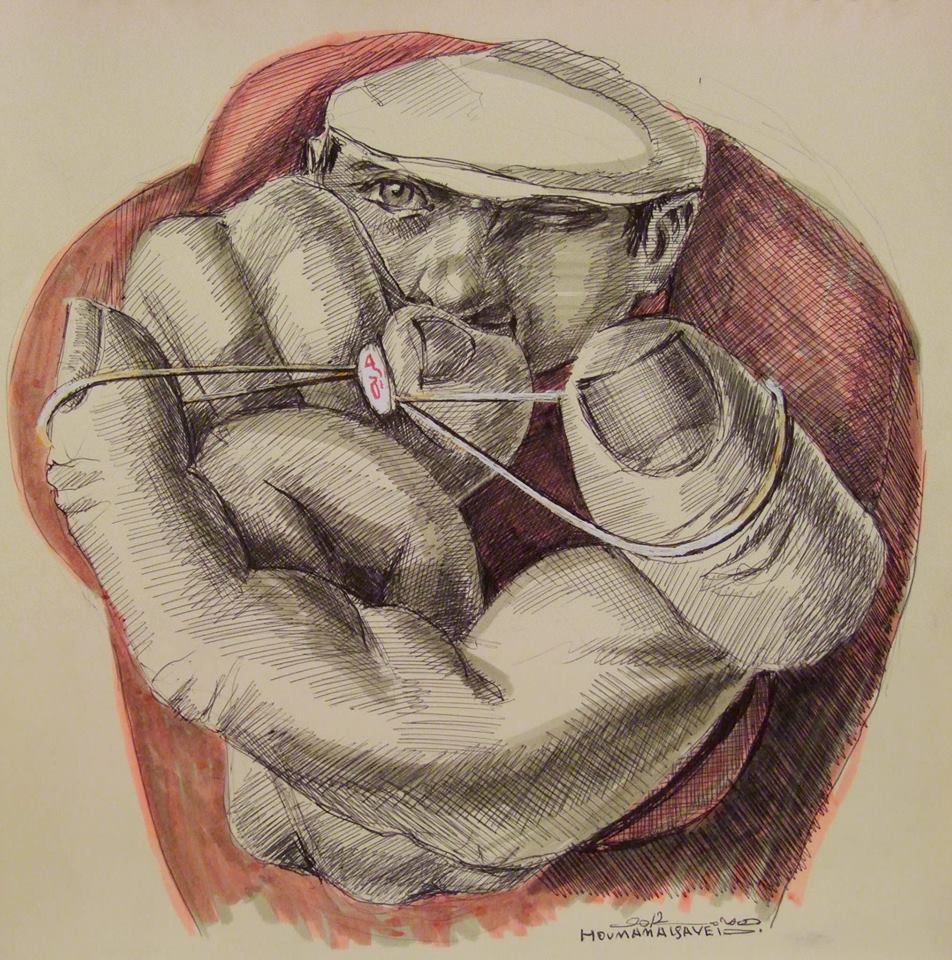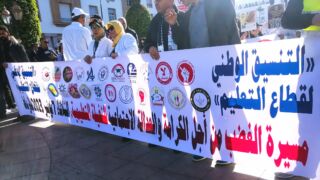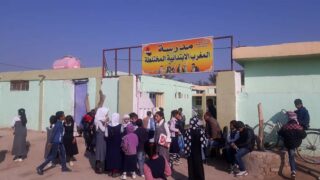
This publication has benefited from the support of the Rosa Luxemburg Foundation. This text may be reproduced in part or in full, provided the source is acknowledged.
The unregulated economy in Morocco finds its roots in the era of French colonialism, when the capitalist systems of production were endorsed as the Moroccan economy became subordinate to the needs of the “Metropole” or the Center. After the end of the French Protectorate in 1956, Morocco has mainly become an exporter of phosphate and agricultural products (recently, car assembly parts have been added to the main exports). The country has not yet witnessed an agricultural reform that would redistribute the land and help in reducing the migration of large segments of people from the rural areas to cities. Also, the industrial sector has not received the same care that has been given to the tourism sector or to the export of agricultural products, for example. As a result, the Moroccan industrial sector remained weak, dependent on light export-oriented industries, dominated by foreign capital (French in particular), and unable to absorb the enormous labor force coming from the rural regions after the demographic explosion.
A disintegrated, subordinate and rentier economy dominated by foreign companies and local monopolies run by those in power could only produce unemployment, poverty and marginalization. Such is the case of the Moroccan economy. This situation was also accompanied by a "Malthusian" educational policy (derived from the name of the English economist Thomas Robert Malthus) that closed the school’s doors on a wide range of Moroccan citizens. According to the latest census, published in 2014, the illiteracy rate in Morocco was of 32 percent, which means that the country is relegated to one of the lowest ranks in schooling and education in the Maghreb and the entire Arab region.
A disintegrated, subordinate and rentier economy dominated by foreign companies and local monopolies run by those in power could only produce unemployment, poverty and marginalization, and such is the case of the Moroccan economy.
The millions of citizens deprived of the right to education and permanent employment are prompted to work in marginal activities or establish illicit “small-capital” projects within the informal economy. The informal economy grew considerably during the decade (1983-1993), in which the “Structural Adjustment Project” was being implemented in Morocco. This decade was marked by an exploding upsurge of unemployment rates, a proliferation of precarious work, a decline in public investment and public employment and a deterioration of the purchasing power of large segments of middle and lower working classes. According to the World Bank, about 70 percent of the jobs created between 1986 and 1990 resulted from the expansion of the parallel economy. (1)
Figures from the Unregulated Sector
Morocco lacks conclusive and comprehensive statistics on the informal economy as a whole. The official figures available mostly cover non-agricultural production units that do not use concrete accounting systems (2). Unfortunately, we have no choice but to rely on the available data.
By the end of the 1990s, the informal sector employed about 39 percent of workers from the non-agricultural sectors, which constitutes nearly 2 million people (3). In 2007, the figure was 37.3 percent (2,166,116 people) (4). Seven years later, in 2014, there was a one-percent decline in the percentage (36.3 percent), despite the increase in the number of informal employees (2,275,922 people in 2014) (5). The number of informal units that constitute the unregulated sector increased from 1.23 million in 1999 to 1.68 million in 2013, most of which (51.4 percent) do not even have a fixed workplace (6).
The informal economy grew considerably during the decade (1983-1993), in which the “Structural Adjustment Project” was being implemented in Morocco. This decade was marked by an exploding upsurge of unemployment rates, a proliferation of precarious work with a decline in public investment and public employment and a deterioration of the purchasing power of large segments of middle and lower working classes.
Investments in this sector mainly rely on “self-financing”: 82.2 percent of these units are self-financed, while only 9 percent tend to borrow money from banks (7). The unregulated sector accounts for 11.5 percent of the gross domestic product (GDP). 77.8 percent of the sales from the informal units are directed toward household consumption. It is also a sector dominated by self-employed workers, with only 17.2 percent of the total workers being employed wage-earners.
The informal sector has therefore maintained its overall economic and social weight in the 15 years between 1999 and 2014, despite all the measures enacted to integrate it into the "structured economy". Its existence is linked to the "pattern of poor development" well-recognized by Morocco and fueled by the neoliberal policies put into practice for the past 35 years. The informal economy is mainly comprised of small trade activities (especially pavement trade) and little enterprises in the industry, services and real estate sectors, which essentially makes it an economic space that encourages activities by the vast masses of the urban proletariat and some of the most vulnerable and exploited working class citizens.
The Political Function: A Resistance Pattern or a Safety Valve?
What is the "political function" of the informal economy in Morocco? Answers to this question take on two different types of approaches and directions:
1- The first approach is that "the function assigned to the presence of precarious work activities" (8) is "to control the reaction of the protest forces and to alleviate social tensions" (9), and that the informal sector functions as a "preventive social mechanism" (10). It acts as a safety valve that maintains the status quo. The hawkers’ role in the protests of 2011 in Morocco, for instance, may have validated this approach. The political authorities allowed them greater freedom to perform their informal activities in exchange for their refrain from joining the "February 20th Movement". As soon as the movement receded, the authorities went back to restricting the movement of hawkers and street vendors, using the complaints of regular merchants and passers-by as an excuse. During the same period, the authorities had also become tolerant toward those who illegally constructed housing units, only to demolish these dwellings and arrest those who built them after the tensions eased in the street. It is clear that manipulating the activity of the informal economy becomes a means of erecting barriers to obstruct the convergence of people’s different struggles and interests and to fuel contradictions and conflicts among them.
2- The second approach views the informal economy as a form of resistance against the power of the neo-liberal state and its models of development. The logic that governs a neoliberal open market starkly contrasts with how a significant part of the informal economy operates, with respect to its reliance on kinship relations and tribal or regional solidarity to mobilize the material and symbolic resources needed for its economic activities. "Bypassing" and "ignoring" the legal arsenal, produced by the neoliberal state that “owns” the public sphere, are "quiet violations committed by ordinary people who – in their quest to survive and improve their living conditions – enable themselves to realize their interests, at the expense of those who own and dominate. The essence of these political practices may be reflected incidentally through a collective act, such as the open, transient and unstructured protests that unfold without a clear central leadership. The successive urban upheavals in Morocco (1965, 1981, 1984, 1990) were fueled by these social groups in particular, which may confirm the validity of this second understanding of the political role of informal economy.
The informal sector functions as a "preventive social mechanism". It acts as a safety valve that maintains the status quo. The hawkers who were allowed greater freedom to perform their informal activities in the wake of the "February 20th Movement" were soon restricted again when the movement receded.
The discrepancy between these two types of approaches and how they understand informal economy reflects the contradiction between a vision that distrusts the masses of the “Lumpenproletariat” and another vision that regards them as the main constituent force of the revolution. It echoes an older debate already discussed in past revolutionary movements, especially in peripheral societies where the masses of the "marginalized" represent a large section of the people, if not the majority. Neoliberal policies, with their devastating effects, have perhaps paved the way to new ideas about overcoming this contradiction. The widespread precariousness and the lack of economic security put the social groups that had previously known employment stability at risk, leading those afflicted to share and transfer their experience in organization and mobilization of protest to others among the oppressed. The students and workers who are part of the informal economy and have some experience in protests and struggles can hence use this opportunity to transfer their organizational expertise to wider groups of people. The protests of "Al-Reef" and "Jerada", in addition to the attempts to organize the street vendors, are a partial product of this experience being transmitted across different groups. It is perhaps one of the most unexpected results of the neoliberal policies.
The content of this publication is the sole responsibility of Assafir Al-Arabi and Rosa Luxemburg Foundation cannot accept any liability for it.
Translated from Arabic by Sabah Jalloul
Published in Assafir Al-Arabi on 14/06/2018
__________________
1- Banque Mondiale, Poverty, adjustement and growth, Kingdom of Morocco, 1993 cité in Mejjati Alami Rajaa, « L’ajustement structurel et la dynamique de l’emploi informel au Maroc », Critique économique n°2, Eté 2002 p. 85-86
2- The accounting system currently in effect in Morocco that the local companies must endorse and act according to.
3- Direction de la Statistique, Enquête nationale sur le secteur informel non agricole 1999-2000, Ministère de la Prévision économique et du Plan, Rabat, 2003
4- Haut Commissariat au Plan, Enquête nationale sur le secteur informel 2006-2007, Rabat, 2009
5- Haut Commissariat au Plan, Présentation des résultats de l’Enquête Nationale sur le Secteur Informel 2013/2014, Rabat, 2016
6- Ibid
7- Ibid
8- Al-Oudi, Mahmoud. “The Layers of poverty in the Informal Sector and its Social Consequences”, Al-Taharror, 1st Edition, p. 122
9- Ibid
10- Ibid p. 121
11- Bayat, Asef. Life as Politics: How Ordinary People Change the Middle East, Stanford University Press, Palo Alto, 2009 p. 90




